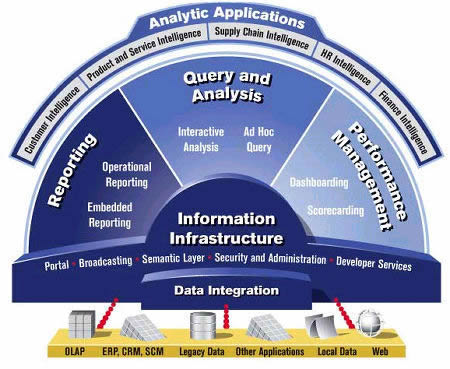 Business Intelligence
Business Intelligence
CIOs have ranked Business
Intelligence among the top 3 most important applications since 2003. In 2012, it was ranked the number one
most important application (Luftman and Derkson 2012).
"Business Intelligence combines technologies--such as
customer relationship management, data warehousing and mining, and knowledge
management --to help organizations leverage their information to make better
and faster decisions. As an
example, one large European telecommunications company analyzes data from its
5.7 million customers. Key
applications, which monitor network utilization and sales force performance, analyze over six terabytes of data. Management is able to drill down in the
data to find specific information about new customers, successful sales
channels, or popular products, and receive that information in easy-to-read,
one page reports. This business intelligence helps management better access
performance and improve operational efficiencies."
(Luftman & McLean, 2004)
Business
intelligence entails significant technical extracts from existing systems and
combining and loading clean data into a business intelligence system that
focuses on data analysis for strategic decision making. This is the essence of
business intelligence.
The group may begin by
briefly explaining the Business Intelligence concept, presenting statistics on
the dollars spent on business intelligence, the promised benefits of business
intelligence, and major challenges.
Your group should show how BI entails significant technical extracts
from existing systems and combining and loading clean data into a business
intelligence system that focuses on data analysis for strategic decision
making. For example, the following
picture shows a conceptual picture of BI:

Source: http://www.piiglobal.com/images/logo_bi.jpg
viewed on Dec 19, 2006
Your presentation should
proceed with two or three case studies of organizations' business intelligence.
(Preferably original case studies but secondary case studies are available)
Case studies should include
the Company Background:
- Size of company in terms of sales and profits
- Major products the company sells
- General characteristics of their customers
- Organizational chart--who does the CIO report to?
- How many people work for the IT organization?
- What is the annual IT budget?
The business
intelligence aspect of the case study should include:
- Picture and good description of the organization's
Business Intelligence
- Who is responsible for Business Intelligence
- Specific example of how Business Intelligence is
used
- What are the perceived benefits and limitations of
the Business Intelligence as described by IT managers/business managers
- What plans does the organization have for the future
of the Business Intelligence
- Lessons learned by the company
Other potential ideas for the
presentation:
- A brief overview or demonstration of Business
Intelligence software (10 minutes or less)
- Major BI suppliers (products, services, revenues,
profits)
The group
should end the presentation on best practices for creating effective Business
Intelligence systems, then map how your cases fit into best practices. This is essentially a cross-case comparison
that integrates your primary (case studies) and secondary (journal articles
& books) research.
If you have
other creative ideas, please feel free to discuss them with me.
This is a good overview of BI:
Watson, H., and Wixom, B. (2007), “The Current State of Business
Intelligence,” IEEE Computer, pp. 96-99.
I like the
article because it explains that the two primary activities of BI are
“getting data in” and “getting data out”:

Some helpful
cases:
CONTINENTAL AIRLINES:
Anderson-Lehman, R., Watson, H., Wixom, B., and Hoffer,
J. (2004) “Continental Airlines Flies High with Real-Time Business
Intelligence,” MIS Quarterly
Executive, Vol. 3, 4, pp. 163-176. Updated in:
Wixom, B.,Watson, H., Reynolds, A.M., Hoffer,
J. (2008) “Continental Airlines Continues to Soar with Business
Intelligence,” Information Systems Management, Vol. 25, pp.
102-112.
CARDINAL HEALTH: Case, T., Schwartzkoph, A., Shaft, T., and Zmud, R., (2005)
“Advanced Business Intelligence at Cardinal Health,” MIS Quarterly Executive, Vol. 4, 4, pp.
413-424).
Some interesting articles in Scholarly Journals:
Davenport, T., Snabe, J.H. (2011), “How Fast and
Flexible Do You Want Your Data, Really?,” MIT Sloan Management Review, Vol. 52,
3, pg. 57.
Hopkins,M., LaValle, S., Balboni, F., Shockley, R., and Kruschwitz, N (2010), “10 Insights: What Survey Reveals about Competing on Information & 10 Data Points: Information and Analytics at Work,” MIT Sloan Management Review, Vol. 52, 1; p. 22.
LaValle, S., Lesser, E., Shockley, R., Hopkins, M.,
and Kruschwitz, N. (2011), “Big Data, Analytics
and the Path From Insights to Value,” MIT Sloan Management Review, Vol. 52, 2;
p. 21.
Williams, S. (2011),
“5 Barriers to BI Success and how to overcome them,”
Strategic Finance, Vol. 93,
1, pp. p. 27-35.
Wixon, B., Watson, H., and Werner, T. (2011),
“Developing an Enterprise Business Intelligence Capability: The Norfolk
Southern Journey,” MIS
Quarterly Executive, Vol.